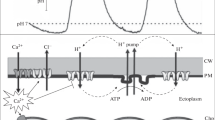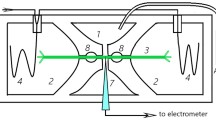Abstract
Photosynthesizing cells of characean algae exposed to light are able to produce pH bands corresponding to alternate areas with dominant H+-pump activity and high H+-conductance of the cell membrane. The action potential generation temporally arrests the counter-directed H+ fluxes, which gives rise to opposite pH shifts in different cell regions and represents a suitable indicator for activities of the plasma membrane H+-transporting systems. Measurements of pH near the cell surface by means of microelectrodes and microspectrophotometry in the presence of pH-indicating dye thymol blue have shown that the treatment of cells with dithiothreitol (SH-group reducing agent) suppresses pH changes induced by the action potential generation in the alkaline cell areas and considerably increases the concurrent pH changes in the acid regions. Measurements of plasma membrane resistance in the alkaline zones revealed that dithiothreitol inhibits the light-dependent conductance of the resting cell and diminishes the conductance inactivation caused by the action potential generation. The data suggest that the reduction of accessible disulfide bonds results in the decrease of H+-conductance, whereas the activity of plasma membrane H+-pump remains unimpaired or is even enhanced.
Similar content being viewed by others
Abbreviations
- AP:
-
action potential
- DTT:
-
dithiothreitol
- pHo :
-
pH in the outer medium in the proximity to cell surface
References
DeCoursey T.E. 2003. Voltage-gated proton channels and other proton transfer pathways. Physiol. Rev. 83, 475–579.
Miedema H., Felle H., Prins H.B.A. 1992. Effect of high pH on the plasma membrane potential and conductance in Elodea densa. J. Membrane Biol. 128, 63–69.
Miedema H., Prins H.B.A. 1992. Coupling of proton fluxes in the polar leaves of Potamogeton lucens L. J. Exp. Bot. 43, 907–914.
Lucas W.J., Keifer D.W., Sanders D. 1983. Bicarbonate transport in Chara corallina: Evidence for cotransport of HCO −3 with H+. J. Membrane Biol. 73, 263–274.
Bulychev A.A., Cherkashin A.A., Rubin A.B., Vredenberg W.J., Zykov V.S., Müller S.C. 2001. Comparative study on photosynthetic activity of chloroplasts in acid and alkaline zones of Chara corallina. Bioelectrochemistry. 53, 225–232.
Bulychev A.A., Vredenberg W.J. 2003. Spatio-temporal patterns of photosystem II activity and plasma-membrane proton flows in Chara corallina cells exposed to overall and local illumination. Planta. 218, 143–151.
Krupenina N.A., Bulychev A.A., Roelfsema M.R.G., Schreiber U. 2008. Action potential in Chara cells intensifies spatial patterns of photosynthetic electron flow and non-photochemical quenching in parallel with inhibition of pH banding. Photochem. Photobiol. Sci. 7, 681–688.
Shimmen T., Wakabayashi A. 2008. Involvement of membrane potential in alkaline band formation by internodal cells of Chara corallina. Plant Cell Physiol. 49, 1614–1620.
Shimmen T., Yonemura S., Negoro M., Lucas W.J. 2003. Studies on alkaline band formation in Chara corallina: Ameliorating effect of Ca2+ on inhibition induced by osmotic shock. Plant Cell Physiol. 44, 957–960.
Bulychev A.A., Krupenina N.A. 2009. Transient removal of alkaline zones after excitation of Chara cells is associated with inactivation of high conductance in the plasmalemma. Plant Signaling & Behavior. 4, 24–31.
Bulychev A.A., van den Wijngaard P.W.J., de Boer A.H. 2005. Spatial coordination of chloroplast and plasma membrane activities in Chara cells and its disruption through inactivation of 14-3-3 proteins. Biochemistry (Moscow). 70, 55–61.
Lucas W.J., Nuccitelli R. 1980. HCO −3 and OH− transport across the plasmalemma of Chara: Spatial resolution obtained using extracellular vibrating probe. Planta. 150, 120–131.
Bulychev A.A., Kamzolkina N.A., Luengviriya J., Rubin A.B., Müller S.C. 2004. Effect of a single excitation stimulus on photosynthetic activity and light-dependent pH banding in Chara cells. J. Membrane Biol. 202, 11–19.
Bulychev A.A., Krupenina N.A. 2010. Inactivation of plasmalemma conductance in alkaline zones of Chara corallina after generation of action potential. Biochemistry (Moscow), Suppl. Series A. 4, 232–239.
Plieth C., Tabrizi H., Hansen U.-P. 1994. Relationship between banding and photosynthetic activity in Chara corallina as studied by the spatially different induction curves of chlorophyll fluorescence observed by an image analysis system. Physiol. Plant. 91, 205–211.
Carpaneto A., Cantu A.M., Gambale F. 1999. Redox agents regulate ion channel activity in vacuoles from higher plant cells. FEBS Lett. 442, 129–132.
Fedorenko A.L., Lozovaya N.A., Volkova T.M., Kryshtal O.A. 2006. Antioxidant-caused changes in the permeability of proton-gated ion channels for sodium and calcium. Neurophysiology. 38, 158–162.
Nelson N., Harvey W.R. 1999. Vacuolar and plasma membrane proton-adenosinetriphosphatases. Physiol. Rev. 79, 361–385.
Bulychev A.A., Kamzolkina N.A., Müller S., Cherkashin A.A., Rubin A.B. 2004. Temporal suppression of periodic pH profile along a charophyte cell after the generation of action potential, Dokl. Biochem. Biophys. 396, 128–131.
Smith J.R., Walker N.A. 1983. Membrane conductance of Chara measured in the acid and basic zones. J. Membr. Biol. 73, 193–202.
Smith J.R., Walker N.A. 1985. Effects of pH and light on the membrane conductance measured in the acid and basic zones of Chara. J. Membr. Biol. 83, 193–205.
Bisson M.A., Walker N.A. 1980. The Chara plasmalemma at high pH. Electrical measurements show rapid specific passive uniport of H+ or OH−. J. Membr. Biol. 56, 1–7.
Sokolik A.I., Yurin V.M. 1986. Potassium channels in plasLmalemma of Nitella cells at rest. J. Membr. Biol. 89, 9–22.
Petrov V.V., Smirnova V.V., Okorokov L.A. 1992. Mercaptoethanol and dithiothreitol decrease the difference of electrochemical proton potentials across the yeast plasma and vacuolar membranes and activate their H+-ATPases. Yeast. 8, 589–598.
Gilmore A.M., Yamamoto H.Y. 1992. Dark induction of zeaxanthin-dependent nonphotochemical fluorescence quenching mediated by ATP. Proc. Natl. Acad. Sci. USA. 89, 1899–1903.
Schwarz O., Schürmann P., Strotmann H. 1997. Kinetics and thioredoxin specificity of thiol modulation of the chloroplast H+-ATPase. J. Biol. Chem. 272, 16924–16927.
Author information
Authors and Affiliations
Corresponding author
Additional information
Original Russian Text © S.O. Dodonova, N.A. Krupenina, A.A. Bulychev, 2010, published in Biologicheskie Membrany, 2010, Vol. 27, No. 5, pp. 404–412.
The article was translated by the authors.
Rights and permissions
About this article
Cite this article
Dodonova, S.O., Krupenina, N.A. & Bulychev, A.A. Suppression of the plasma membrane H+-conductance on the background of high H+-pump activity in dithiothreitol-treated Chara cells. Biochem. Moscow Suppl. Ser. A 4, 389–396 (2010). https://doi.org/10.1134/S1990747810040094
Received:
Published:
Issue Date:
DOI: https://doi.org/10.1134/S1990747810040094




